Abstract
The mechanism of lithium-induced diabetes insipidus was investigated in 96 patients and in a rat model. Polydipsia was reported by 40% and polyuria (more than 3 liter/day) by 12% of patients receiving lithium. Maximum concentrating ability after dehydration and vasopressin was markedly impaired in 10 polyuric patients and was reduced in 7 of 10 nonpolyuric patients studied before and during lithium therapy. Severe polyuria (more than 6 liter/day) was unresponsive to trials of vasopressin and chlorpropamide, but improved on chlorothiazide. Rats receiving lithium (3-4 meq/kg/day) developed massive polyuria that was resistant to vasopressin, in comparison to rats with comparable polyuria induced by drinking glucose. Analysis of renal tissue in rats with lithium polyuria showed progressive increase in the concentration of lithium from cortex to papilla with a 2.9-fold corticopapillary gradient for lithium. The normal corticopapillary gradient for sodium was not reduced by lithium treatment. The polyuria was not interrupted by brief intravenous doses of vasopressin (5-10 mU/kg) or dibutyryl cyclic AMP (10-15 mg/kg) capable of reversing water diuresis in normal and hypothalamic diabetes insipidus rats (Brattleboro strain). The present studies suggest that nephrogenic diabetes insipidus is a common finding after lithium treatment and results in part from interference with the mediation of vasopressin at a step distal to the formation of 3′,5′ cyclic AMP.
Full text
PDF
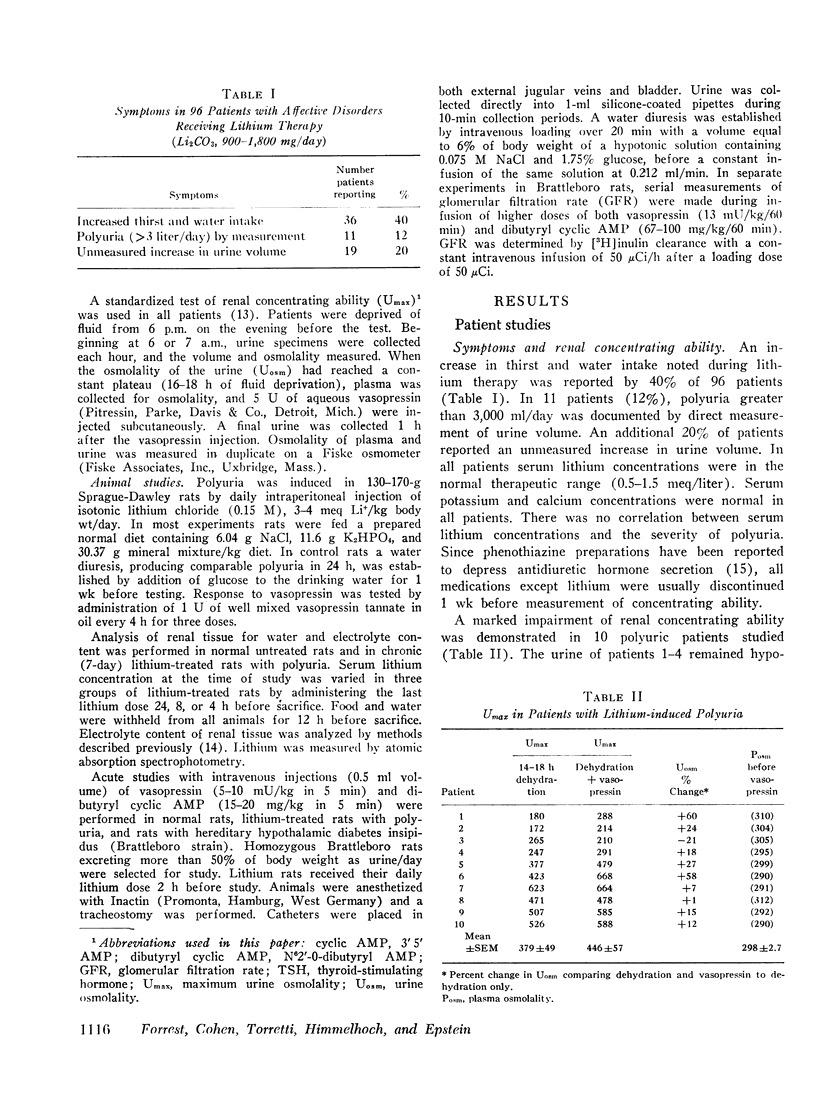
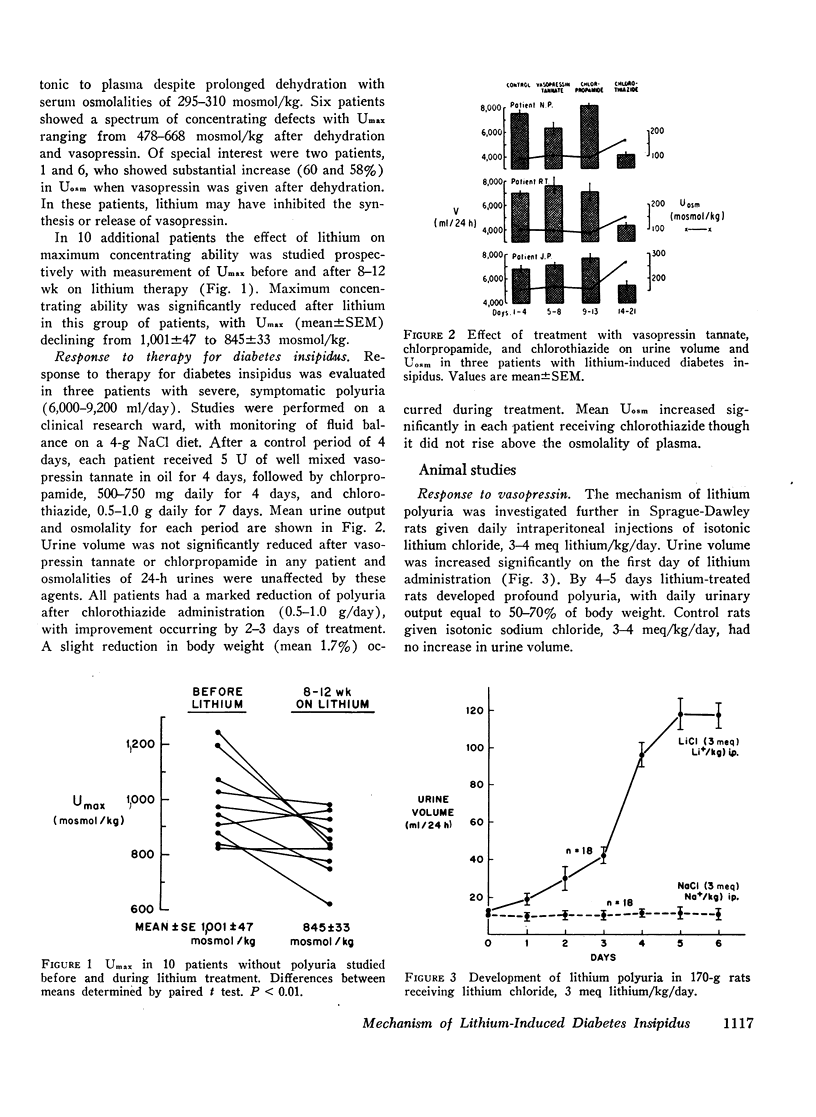
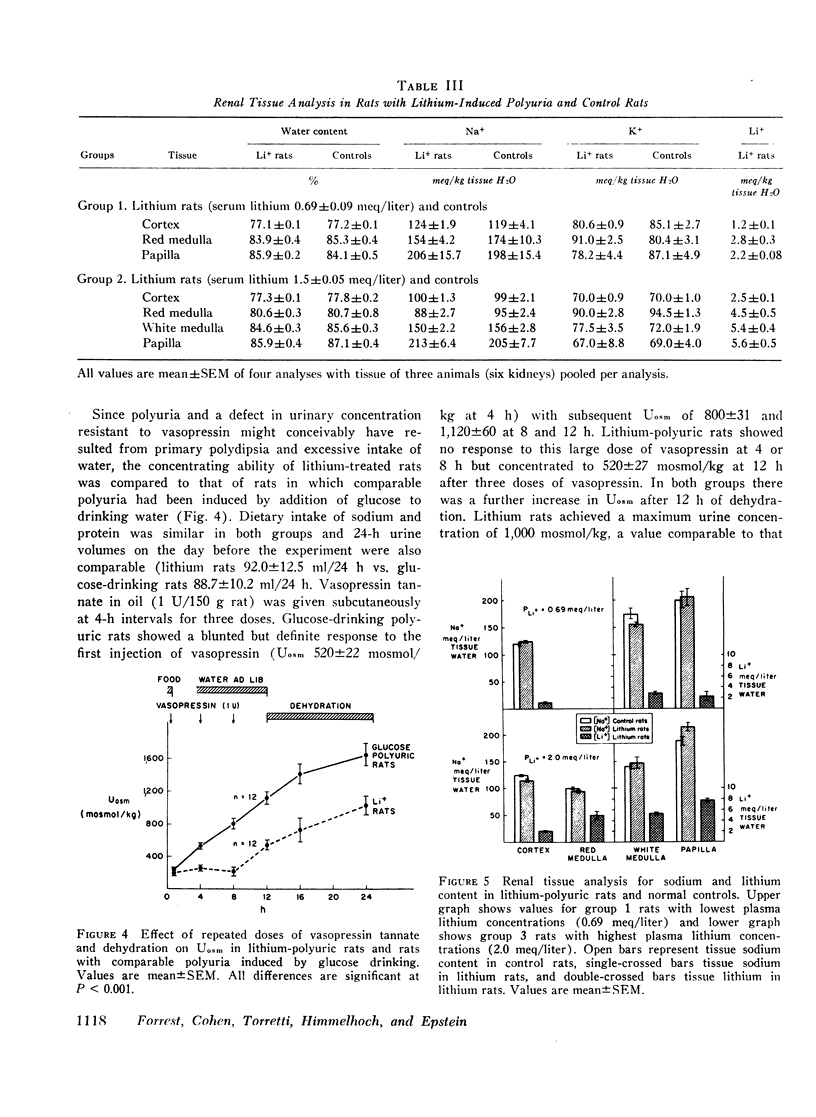

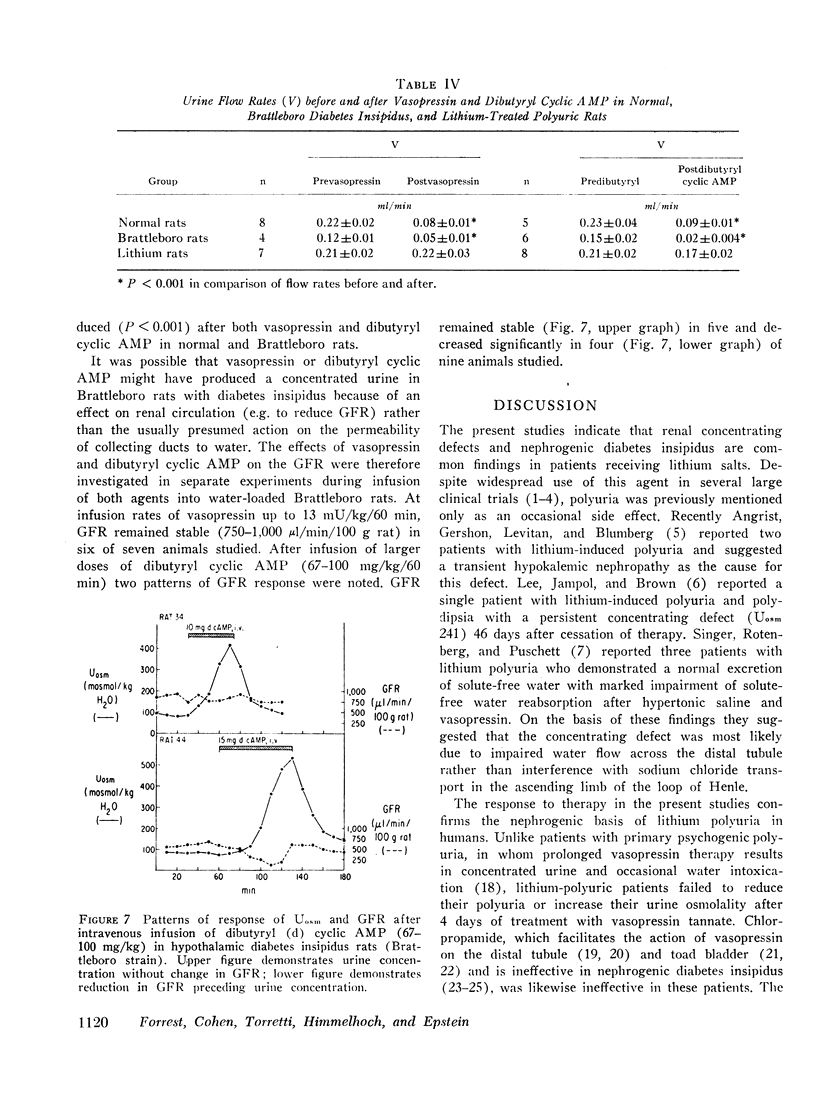
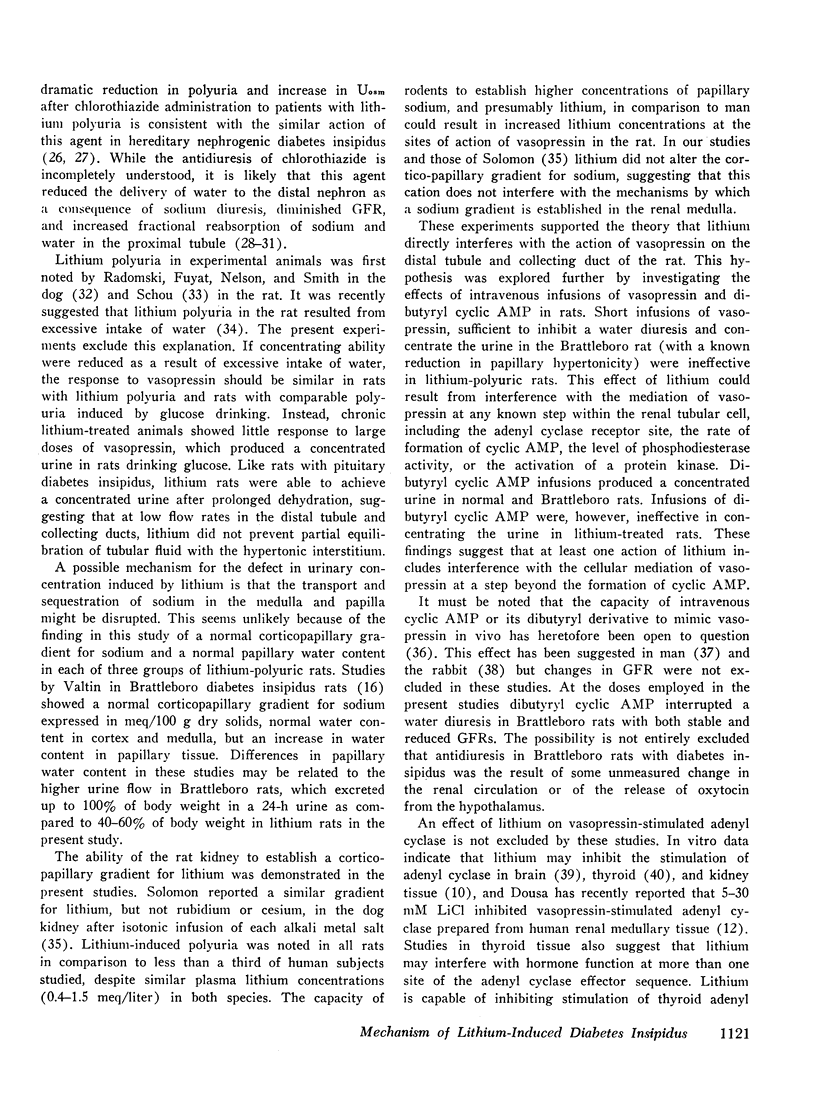
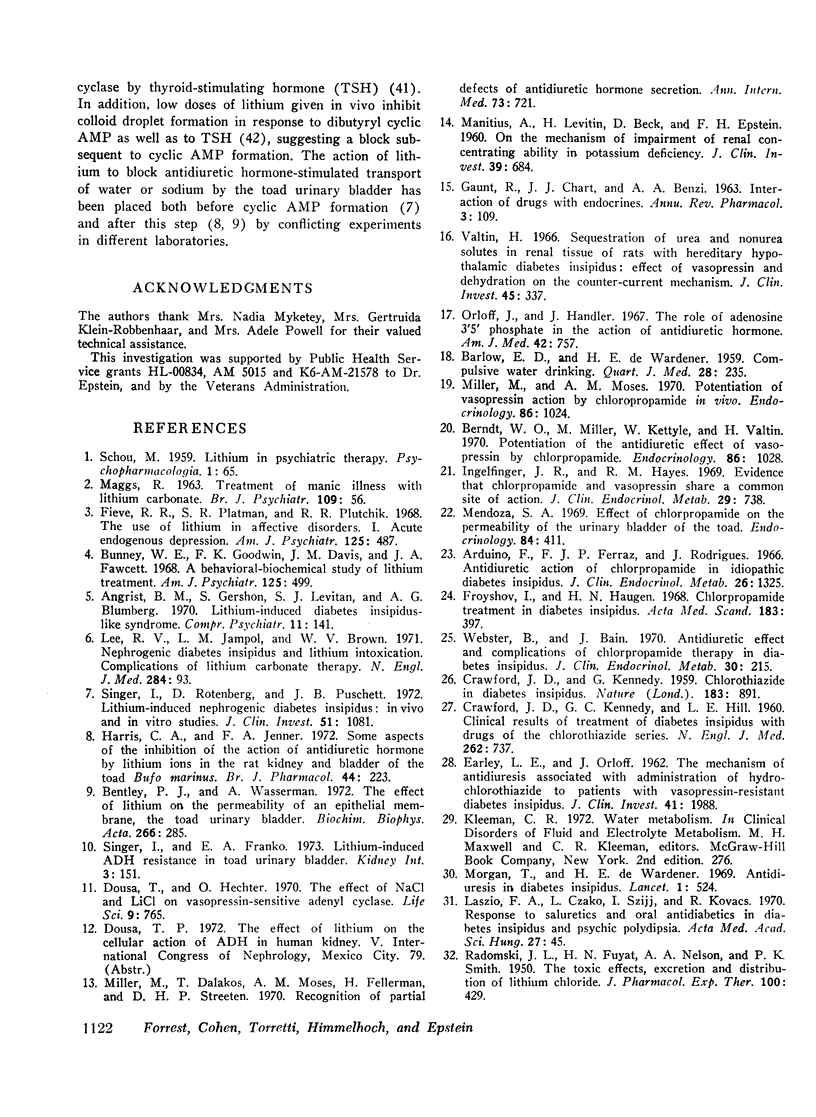
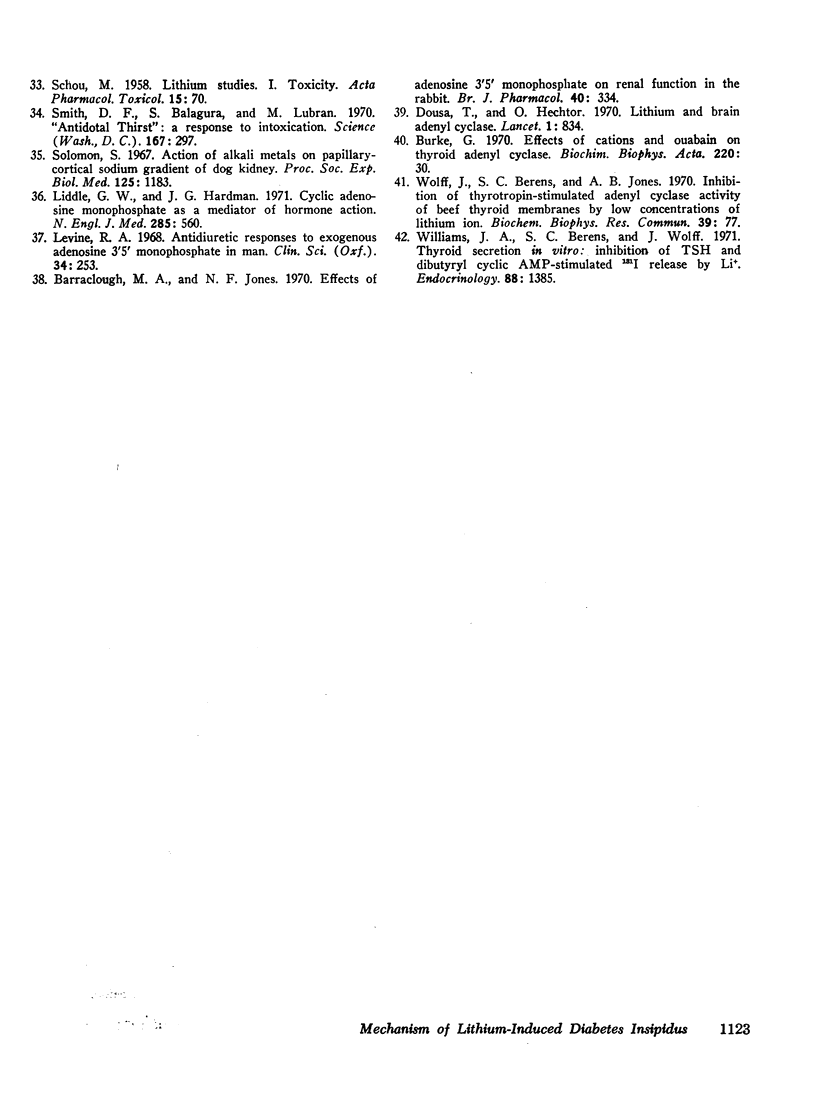
Selected References
These references are in PubMed. This may not be the complete list of references from this article.
- Angrist B. M., Gershon S., Levitan S. J., Blumberg A. G. Lithium-induced diabetes insipidus-like syndrome. Compr Psychiatry. 1970 Mar;11(2):141–146. doi: 10.1016/0010-440x(70)90155-0. [DOI] [PubMed] [Google Scholar]
- Arduino F., Ferraz F. P., Rodrigues J. Antidiuretic action of chlorpropamide in idiopathic diabetes insipidus. J Clin Endocrinol Metab. 1966 Dec;26(12):1325–1328. doi: 10.1210/jcem-26-12-1325. [DOI] [PubMed] [Google Scholar]
- BARLOW E. D., DE WARDENER H. E. Compulsive water drinking. Q J Med. 1959 Apr;28(110):235–258. [PubMed] [Google Scholar]
- Barraclough M. A., Jones N. F. Effects of adenosine 3',5'-monophosphate on renal function in the rabbit. Br J Pharmacol. 1970 Oct;40(2):334–341. doi: 10.1111/j.1476-5381.1970.tb09926.x. [DOI] [PMC free article] [PubMed] [Google Scholar]
- Bentley P. J., Wasserman A. The effects of lithium on the permeability of an epithelial membrane, the toad urinary bladder. Biochim Biophys Acta. 1972 Apr 14;266(1):285–292. doi: 10.1016/0005-2736(72)90143-5. [DOI] [PubMed] [Google Scholar]
- Berndt W. O., Miller M., Kettyle W. M., Valtin H. Potentiation of the antidiuretic effect of vasopressin by chlorpropamide. Endocrinology. 1970 May;86(5):1028–1032. doi: 10.1210/endo-86-5-1028. [DOI] [PubMed] [Google Scholar]
- Bunney W. E., Jr, Goodwin F. K., Davis J. M., Fawcett J. A. A behavioral-biochemical study of lithium treatment. Am J Psychiatry. 1968 Oct;125(4):499–512. doi: 10.1176/ajp.125.4.499. [DOI] [PubMed] [Google Scholar]
- Burke G. Effects of cations and ouabain on thyroid adenyl cyclase. Biochim Biophys Acta. 1970 Oct 14;220(1):30–41. doi: 10.1016/0005-2744(70)90226-3. [DOI] [PubMed] [Google Scholar]
- CRAWFORD J. D., KENNEDY G. C. Chlorothiazid in diabetes insipidus. Nature. 1959 Mar 28;183(4665):891–892. doi: 10.1038/183891a0. [DOI] [PubMed] [Google Scholar]
- CRAWFORD J. D., KENNEDY G. C., HILL L. E. Clinical results of treatment of diabetes insipidus with drugs of the chlorothiazide series. N Engl J Med. 1960 Apr 14;262:737–743. doi: 10.1056/NEJM196004142621501. [DOI] [PubMed] [Google Scholar]
- Dousa T., Hechter O. Lithium and brain adenyl cyclase. Lancet. 1970 Apr 18;1(7651):834–835. doi: 10.1016/s0140-6736(70)92429-3. [DOI] [PubMed] [Google Scholar]
- Dousa T., Hechter O. The effect of NaCl and LiCl on vasopressin-sensitive adenyl cyclase. Life Sci I. 1970 Jul 1;9(13):765–770. doi: 10.1016/0024-3205(70)90286-9. [DOI] [PubMed] [Google Scholar]
- Earley L. E., Orloff J. THE MECHANISM OF ANTIDIURESIS ASSOCIATED WITH THE ADMINISTRATION OF HYDROCHLOROTHIAZIDE TO PATIENTS WITH VASOPRESSIN-RESISTANT DIABETES INSIPIDUS. J Clin Invest. 1962 Nov;41(11):1988–1997. doi: 10.1172/JCI104657. [DOI] [PMC free article] [PubMed] [Google Scholar]
- Fieve R. R., Platman S. R., Plutchik R. R. The use of lithium in affective disorders. I. Acute endogenous depression. Am J Psychiatry. 1968 Oct;125(4):487–491. doi: 10.1176/ajp.125.4.487. [DOI] [PubMed] [Google Scholar]
- Froyshov I., Haugen H. N. Chlorpropamide treatment in diabetes insipidus. Acta Med Scand. 1968 Apr;183(4):397–400. doi: 10.1111/j.0954-6820.1968.tb10498.x. [DOI] [PubMed] [Google Scholar]
- Harris C. A., Jenner F. A. Some aspects of the inhibition of the action of antidiuretic hormone by lithium ions in the rat kidney and bladder of the toad Bufo marinus. Br J Pharmacol. 1972 Feb;44(2):223–232. [PMC free article] [PubMed] [Google Scholar]
- Ingelfinger J. R., Hays R. M. Evidence that chlorpropamide and vasopressin share a common site of action. J Clin Endocrinol Metab. 1969 May;29(5):738–740. doi: 10.1210/jcem-29-5-738. [DOI] [PubMed] [Google Scholar]
- Levine R. A. Antiduretic responses to exogenous adenosine 3',5'-monophosphate in man. Clin Sci. 1968 Apr;34(2):253–260. [PubMed] [Google Scholar]
- Liddle G. W., Hardman J. G. Cyclic adenosine monophosphate as a mediator of hormone action. N Engl J Med. 1971 Sep 2;285(10):560–566. doi: 10.1056/NEJM197109022851007. [DOI] [PubMed] [Google Scholar]
- László F. A., Czakó L., Szijj I., Kovács K. Response to saluretics and oral antidiabetics in diabetes insipidus and psychic polydipsia. Acta Med Acad Sci Hung. 1970;27(1):45–55. [PubMed] [Google Scholar]
- MANITIUS A., LEVITIN H., BECK D., EPSTEIN F. H. On the mechanism of impairment of renal concentrating ability in potassium deficiency. J Clin Invest. 1960 Apr;39:684–692. doi: 10.1172/JCI104084. [DOI] [PMC free article] [PubMed] [Google Scholar]
- Mendoza S. A. Effect of chlorpropamide on the permeability of the urinary bladder of the toad and the response to vasopressin, adenosine-3',5'-monophosphate and theophylline. Endocrinology. 1969 Feb;84(2):411–414. doi: 10.1210/endo-84-2-411. [DOI] [PubMed] [Google Scholar]
- Miller M., Dalakos T., Moses A. M., Fellerman H., Streeten D. H. Recognition of partial defects in antidiuretic hormone secretion. Ann Intern Med. 1970 Nov;73(5):721–729. doi: 10.7326/0003-4819-73-5-721. [DOI] [PubMed] [Google Scholar]
- Miller M., Moses A. M. Potentiation of vasopressin action by chlorpropamide in vivo. Endocrinology. 1970 May;86(5):1024–1027. doi: 10.1210/endo-86-5-1024. [DOI] [PubMed] [Google Scholar]
- Morgan T., De Wardener H. E. Antidiuresis in diabetes insipidus. Lancet. 1969 Mar 8;1(7593):524–525. doi: 10.1016/s0140-6736(69)91612-2. [DOI] [PubMed] [Google Scholar]
- Orloff J., Handler J. The role of adenosine 3',5'-phosphate in the action of antidiuretic hormone. Am J Med. 1967 May;42(5):757–768. doi: 10.1016/0002-9343(67)90093-9. [DOI] [PubMed] [Google Scholar]
- RADOMSKI J. L., FUYAT H. N., NELSON A. A., SMITH P. K. The toxic effects, excretion and distribution of lithium chloride. J Pharmacol Exp Ther. 1950 Dec;100(41):429–444. [PubMed] [Google Scholar]
- SCHOU M. Lithium in psychiatric therapy. Stock-taking after ten years. Psychopharmacologia. 1959;1:65–78. doi: 10.1007/BF00408113. [DOI] [PubMed] [Google Scholar]
- SCHOU M. Lithium studies. 1. Toxicity. Acta Pharmacol Toxicol (Copenh) 1958;15(1):70–84. doi: 10.1111/j.1600-0773.1958.tb00287.x. [DOI] [PubMed] [Google Scholar]
- Singer I., Franko E. A. Lithium-induced ADH resistance in toad urinary bladders. Kidney Int. 1973 Mar;3(3):151–159. doi: 10.1038/ki.1973.23. [DOI] [PubMed] [Google Scholar]
- Singer I., Rotenberg D., Puschett J. B. Lithium-induced nephrogenic diabetes insipidus: in vivo and in vitro studies. J Clin Invest. 1972 May;51(5):1081–1091. doi: 10.1172/JCI106900. [DOI] [PMC free article] [PubMed] [Google Scholar]
- Smith D. F., Balagura S., Lubran M. "Antidotal thirst": a response to intoxication. Science. 1970 Jan 16;167(3916):297–298. doi: 10.1126/science.167.3916.297. [DOI] [PubMed] [Google Scholar]
- Solomon S. Action of alkali metals on papillary-cortical sodium gradient of dog kidney. Proc Soc Exp Biol Med. 1967 Aug-Sep;125(4):1183–1186. doi: 10.3181/00379727-125-32308. [DOI] [PubMed] [Google Scholar]
- Valtin H. Sequestration of urea and nonurea solutes in renal tissues of rats with hereditary hypothalamic diabetes insipidus: effect of vasopressin and dehydration on the countercurrent mechanism. J Clin Invest. 1966 Mar;45(3):337–345. doi: 10.1172/JCI105348. [DOI] [PMC free article] [PubMed] [Google Scholar]
- Webster B., Bain J. Antidiuretic effect and complications of chlorpropamide therapy in diabetes insipidus. J Clin Endocrinol Metab. 1970 Feb;30(2):215–227. doi: 10.1210/jcem-30-2-215. [DOI] [PubMed] [Google Scholar]
- Williams J. A., Berens S. C., Wolff J. Thyroid secretion in vitro: inhibition of TSH and dibutyryl cyclic-AMP stimulated 131-I release by Li+1. Endocrinology. 1971 Jun;88(6):1385–1388. doi: 10.1210/endo-88-6-1385. [DOI] [PubMed] [Google Scholar]
- Wolff J., Berens S. C., Jones A. B. Inhibition of thyrotropin-stimulated adenyl cyclase activity of beef thyroid membranes by low concentration of lithium ion. Biochem Biophys Res Commun. 1970 Apr 8;39(1):77–82. doi: 10.1016/0006-291x(70)90760-6. [DOI] [PubMed] [Google Scholar]


